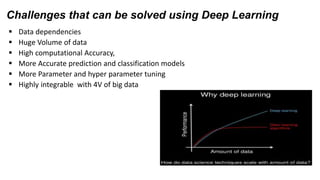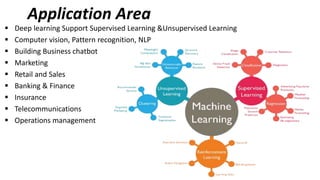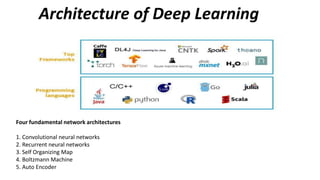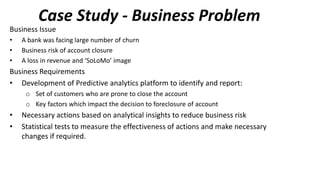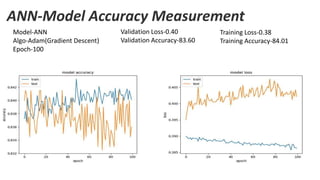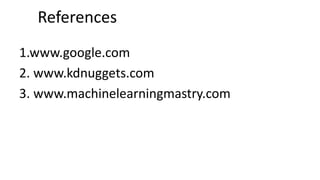Deep learning
- 1. Deep Learning Arun Shukla Senior Consultant Data Science|Machine Learning|Deep Learning
- 3. Content About Deep Learning Challenges that can be solved using Deep Learning Applications Architecture Framework of Deep Learning Holistic Approach To End-to-End Solution Building Case study • Business Challenges • Solution Approach and Execution • Comparison with other Models
- 4. About Deep Learning Deep Learning is a subset of Machine Learning, grown out from the field of AI • A field that examines computer algorithms that learn and improve on their own • Neural networks, a beautiful biologically-inspired programming paradigm which enables a computer to learn from observational data
- 5. Challenges that can be solved using Deep Learning Data dependencies Huge Volume of data High computational Accuracy, More Accurate prediction and classification models More Parameter and hyper parameter tuning Highly integrable with 4V of big data
- 6. Application Area Deep learning Support Supervised Learning &Unsupervised Learning Computer vision, Pattern recognition, NLP Building Business chatbot Marketing Retail and Sales Banking & Finance Insurance Telecommunications Operations management
- 7. Architecture of Deep Learning Four fundamental network architectures 1. Convolutional neural networks 2. Recurrent neural networks 3. Self Organizing Map 4. Boltzmann Machine 5. Auto Encoder
- 8. Framework of Deep Learning Processed Data Labeled data Unlabeled data Predicted Item-1 Item-2 Item-3 Item-4
- 9. Holistic Approach To End-to-End Solution Building Model Validation K Fold Validation, Accuracy Measurement, Confusion Metrix, Hyper Parameter tuning. Model Design Work frame Selection, Algorithm Selection, Training and Testing of Model Data Pre Processing Data understanding, Label/unlabeled data, Missing/NAN values, Descriptive/Statistical Analysis, Business Problem Business objective, Pain point, Key requirement, Scope of work Model deployment Best Accurate Tuned Model
- 10. Case Study - Business Problem Business Issue • A bank was facing large number of churn • Business risk of account closure • A loss in revenue and ‘SoLoMo’ image Business Requirements • Development of Predictive analytics platform to identify and report: o Set of customers who are prone to close the account o Key factors which impact the decision to foreclosure of account • Necessary actions based on analytical insights to reduce business risk • Statistical tests to measure the effectiveness of actions and make necessary changes if required.
- 11. Solution Approach & Execution 11 Validation Data Raw Data Feature Engineering (13 feature) Training Data Modeling ANN-1 Logistic-2 SVM-3 Model Validation Select best Model Scoring of Model Customer Tagging Approach • Integration of various datasets • Exploration of datasets • Treatment of missing values • Creation of dummy variable • Correlation between features • Application of several predictive algorithms • Select best algorithm based on prediction accuracy • Tagging of customers based on predictive model based scores
- 12. Statistic of Data 12 Correlation matrix with in features and with dependent variable
- 13. Statistic of Data 13 0-Female 1-Male Histogram of Age 1-Spain 2-Germany 3.france Histogram of Geography Histogram of Age Histogram of credit score Histogram of Tenure Histogram of Features
- 14. ANN-Model Accuracy Measurement Model-ANN Algo-Adam(Gradient Descent) Epoch-100 Validation Loss-0.40 Validation Accuracy-83.60 Training Loss-0.38 Training Accuracy-84.01
- 15. Comparison with other models 15 CONFUSION MATRIX ANN SVM Logistic 0 1 0 1 0 1 0 1532 73 0 1517 98 0 1526 69 1 254 141 1 255 130 1 309 96 % Accuracy=83.65 % Accuracy=82.35 % Accuracy=81.1 Model-2 SVM Classification Model-3 Logistic Regression Model-1 ANN
- 16. Thank You…





